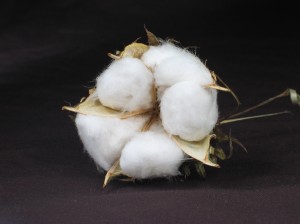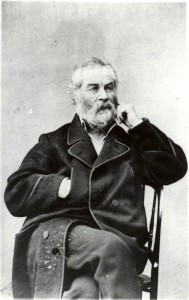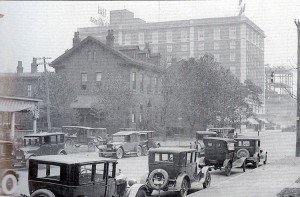
Close-up of Raw Wool
Pre-Civil War, cotton was the primary material used to create clothing. The product was relatively cheap (labor cost, obviously, was not an issue) and there were not tariffs on the material, keeping production overhead relatively low. With the onset of the Civil War, however, wartime activity cut numerous supply lines to the North, which dealt primarily with manufacturing. One of these supply lines happened to be the supply of raw cotton that Northern manufacturers relied upon to produce clothing.

With these limitations in place, Civil-War America had “a textile industry which could not get a fraction of all the cotton it wanted, [so it] turned increasingly to the production of woolen fabrics (here likewise government requirements had skyrocketed), and the market for raw wool was never livelier” (Catton 159). The changes in manufacturing also brought on changes in clothing styles during the early-to-mid 1860s. The standardization of men’s clothing became a movement in the clothing industry in the 1860s, whereas in the 1850s men had a certain amount of latitude with the way they dressed.

Walt Whitman himself participated in this change in fashion: “Whitman dressed differently from before. That was the first thing John Townsend Trowbridge noticed when he visited Whitman in Washington late in 1863” (Reynolds 432). What Trowbridge noted was the transformation in Whitman’s style of clothing from the rebellious, colorful “loafer” of the 1850s, to the more somber, reserved Whitman of the 1960s. Whitman’s transformation in fashion also led to a conflict in the perception of the poet by his friends and admirers: “As for Burroughs’s claim that Whitman was no rough but instead clean and wholesome, it had some validity with regard to the public, postbellum Whitman, with his simple woolen suits and sparkling white linen shirts” (460). This transformation in Whitman’s style, and the fashion of the period in general, was not a coincidence or the whim of fashion, “changing clothing styles signified larger changes in society and culture” (432). The weak government of the antebellum period transformed itself into a powerful agent in America’s culture and Whitman became a part of the “war machine” during the decade he spent in Washington, D.C.. He was now the good grey bard.
However, this was not the only connection that wool had to Whitman’s life. Even years after the initial effects of the Civil War (roughly twenty years, to be exact) wool was still having an impact on Whitman’s life because of where he lived—Camden. Right across the river from Philadelphia, a major industrial hub, Camden itself benefited from the increased need for wool.

The Camden Woolen Mills, which shared a building with a dying factory, were located at 611 Cooper Street and were just one example of the numerous businesses dealing with worsted wool in Camden, NJ in the 1880s and 1890s, towards the end of Walt Whitman’s life. With the increased popularity and demand for woolen goods, however, came the “threat” of foreign competition. During the 1880s and 1890s, one of the most hotly contested actions of government interacting with industry was the debate over tariffs on wool. American wool was considered expensive and of a poorer quality than that which could be obtained through trade with foreign producers of wool. The “average rate of duty on manufactures of woolens in 1887 was 67.21 per cent” (New York Times Sep 24, 1888), whereas under the proposed bill it would be lowered to a uniform rate of 40 percent. Opinions varied greatly as to the effects of this lowered tariff, arguing that it would destroy domestic industry (New York Times Mar 7 1883), or that it would prove beneficial to consumers because of the lowered cost of production (New York Times Sep 24, 188) and prove to cause little harm to domestic industry (Town Topics July 26 1888). By January of 1890, two years before the death of Whitman, the issue was finally being weighed by the Committee of Ways and Means in the House of Representatives. The decision of the Ways and Means Committee lead to the creation of the McKinley Tariff Act.
Works Cited
Catton, Bruce. The Civil War. New York, NY: The American Heritage Library, 1988.
Cohen, Phil. “611 Cooper Street, 1920s.” DVRBS.com. <http://www.dvrbs.com/camden-streets/CamdenStreets/Cooper-605-1920s-1b.jpg>
cyphs-stockup. “Cotton Bowl.” Deviantart.com. 17 Oct 2003. <http://cyphs-stockup.deviantart.com/art/Cotton-Bowl-3475420>
“Free Wool Demanded.” New York Times 3 Jan 1890: 5. Print.
Gardner, Alexander. “Walt Whitman.” Alderman Library, University of Virginia, 1863. <http://www.whitmanarchive.org/multimedia/images/large/012.jpg>
gatagataa-no. “Wool.” Deviantart.com. 25 Sep 2005. <http://gatagataa-no.deviantart.com/art/Wool-22953533>
“Opinions on the Tariff.” New York Times 7 Mar 1883: 2. Print.
Reynolds, David S.. Walt Whitman’s America: A Cultural Biography. New York, NY: Vintage Books, 1996.
“Saunterings.” Town Topics 26 July 1888: 12. Print.
“Woolen Goods and Their Consumers.” New York Times 24 Sep 1888: 5. Print.
 The history of the Vault at Pfaff’s is the history of not only a place, but of the people who frequented its tables. The Vault was opened in 1855 by Charles Ignatious Pfaff, a foreigner with ascetic tastes, on Broadway near the corner of Bleeker Street. Sources disagree as to the exact address of the original Pfaff’s, with one stating it as 689 Broadway (Reynolds 376) and another as 653 Broadway (Miller 89). Regardless of the exact address, Pfaff’s was located in the heart of what was then a cultural hub of New York, Greenwich Village. Pffaf’s was dark and smoky with tables, seats and barrels for sitting on that were scattered around; it was known for its coffee, German beers, cheeses, and a fully stocked wine cellar (Miller 89). This setting attracted the budding Bohemian literary movement of the time. The original Bohemian lifestyle was born in France. Initially it was the necessary lifestyle of the starving artist, but soon it became romanticized into an ideal of shunning the emerging capitalist way of life and embracing art as the greatest truth. This romanticization emigrated to New York and found its home in Greenwich Village. Men were the most frequent visitors at Pfaff’s but, because of progressive ideals of the Bohemian mindset, women with strong characters also became famous frequenters. The Vault at Pfaff’s was so centrifugal to the Bohemian movement in America that the first group of American Bohemians became simply known as “Pfaffians”.
The history of the Vault at Pfaff’s is the history of not only a place, but of the people who frequented its tables. The Vault was opened in 1855 by Charles Ignatious Pfaff, a foreigner with ascetic tastes, on Broadway near the corner of Bleeker Street. Sources disagree as to the exact address of the original Pfaff’s, with one stating it as 689 Broadway (Reynolds 376) and another as 653 Broadway (Miller 89). Regardless of the exact address, Pfaff’s was located in the heart of what was then a cultural hub of New York, Greenwich Village. Pffaf’s was dark and smoky with tables, seats and barrels for sitting on that were scattered around; it was known for its coffee, German beers, cheeses, and a fully stocked wine cellar (Miller 89). This setting attracted the budding Bohemian literary movement of the time. The original Bohemian lifestyle was born in France. Initially it was the necessary lifestyle of the starving artist, but soon it became romanticized into an ideal of shunning the emerging capitalist way of life and embracing art as the greatest truth. This romanticization emigrated to New York and found its home in Greenwich Village. Men were the most frequent visitors at Pfaff’s but, because of progressive ideals of the Bohemian mindset, women with strong characters also became famous frequenters. The Vault at Pfaff’s was so centrifugal to the Bohemian movement in America that the first group of American Bohemians became simply known as “Pfaffians”.